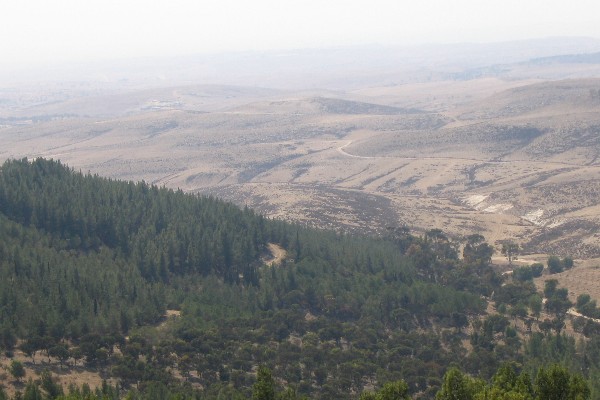If you are looking to sample great wine, enjoy beautiful nature, and see incredible archeology, the Yatir forest is waiting for you!
By Nosson Shulman, Licensed Tour Guide
“And in the mountain… Anab, and Eshtemoh, and Anim.” (Joshua 15: 48-50)
Today we are travelling to biblical Anim, a spot seldom explored by tourists or locals, beautifully located in the Yatir forest (Israel’s largest) in the Southern Hebron Hills.
Like most of Israel’s current forests, this forest was hand-planted by the JNF (since 1964 they have planted more than four million trees here). This stunning area covers approximately 40,000 dunams (10,000 acres).
At the southern edge of the forest, the extreme Negev Desert dramatically appears (seemingly out of nowhere).
Because of the dramatic change in climate and vegetation, many universities and scientific institutions have set up sophisticated research centers, conducting important environmental experiments. Scientists have discovered that this hand-planted forest has halted all desertification northwards (at a time where most deserts, such as the Sahara, grow exponentially each year).
The research conducted in this “living laboratory” forest is very scientifically important.

At the very edge of this luscious forest, the mighty Negev Desert dramatically appears. (Wikimedia Commons)
There is so much to do here, beautiful hiking trails, archeology, and a vineyard that has a world class winery.
The most incredible archeology can be found in an ancient Jewish town (existing here for thousands of years), the biblical Anim! This town was located in the tribal territory of Judah (see Joshua 15:55). A very powerful fortress, with walls five meters (or 16 feet) thick was built here during the Judean monarchy and destroyed in 422 BCE when the Babylonians conquered Israel.
After the Jews were exiled by the Babylonians, the residents of Edom (just south of Israel) took the opportunity to move into the abandoned homes and lands of Southern Israel. When the Jews first returned to Israel in the Persian era 50 years after the exile, the region around Anim and the Yatir forest continued to be occupied by the Edomites. In 112 BCE the Jewish, Maccabean King John Hyrcanus successfully waged a campaign against them, resulting in Israel once again gaining control of southern Israel (which included Anim).
The Jewish community continued to flourish during the Roman times and Byzantine period.
After the Bar Kochva revolt, circa 132-135 CE, the Romans subsequently forbade Jews (for centuries) from living “anywhere” in Judea (and subsequently, the center of Jewish life in Israel moved almost entirely to the Galilee). But somehow, Jews continued to live and flourish in the cities of the Southern Hebron Hills, despite it being part of Judea.
There is so much to do here, beautiful hiking trails, archeology, and a vineyard that has a world class winery. (Wikimedia Commons)
(As an important side note, in order to punish the Jews after the revolt, the Romans changed the name of the province from Judea to Palestine. They named it after the Philistines, the Biblical enemy of the Jews, to humiliate them. The name was purposely chosen after the name of a nation that no longer existed. This happened many centuries before the advent of Islam, and there has never been a distinct Arab nation called Palestine).
The town of Anim became wealthy from agriculture and industry (many wine and olive oil presses in good condition can be seen here). In the 4th Century, a massive synagogue was built here, which was in use into 7th Century. It was built on the highest point in town (in accordance with Jewish law).
The synagogue’s ruins and frame are very well preserved and its built-in benches and Torah ark are still seen here.
The Anim Synagogue. The Torah scrolls were kept in the ark, whose base and foundation are clearly still seen. (Wikimedia Commons)
In the 7th century, Anim (and most of the Southern Hebron Hills) were mysteriously abandoned. This was possibly due to the breakdown of central rule at the end of the Byzantine period and early Islamic period.
Since Anim was on the edge of the desert at a time of weak governance, living in such proximity to desert warriors may have become too dangerous (the fact that the town wasn’t destroyed physically by conquest and not many material goods were found, suggests that the people who left took their movable property with them, lending credence to this theory).
In the later Islamic period (circa 13th and 14th century) a small Islamic village existed here, and a mosque was built on top of the synagogue (during excavations in the 1980s, archeologists removed the mosque, which had been inactive for centuries, and found the synagogue under it). By Ottoman times, the town was abandoned and has since laid in ruins.
On your next trip to Israel, if you are looking to sample great wine, enjoy beautiful nature, and see incredible archeology, the Yatir forest is waiting for you!
Nosson Shulman is a journalist and Licensed Tour Guide in Israel specializing in Biblical tours. To allow tourists to experience Israel during the Corona era, he created the new hit Israel tour video series, which brings Israel to the home of viewers by simulating actual tours. To check out his free sneak preview tour videos, click here. To view sample tour itineraries or to inquire about private tour opportunities with a personalized itinerary on your next trip to Israel, click here.
MAKE THE LAND OF ISRAEL EVEN MORE BEAUTIFUL!
PLANT YOUR VERY OWN FRUIT TREES IN ISRAEL!
Farmers near the Gaza border lost family, friends and workers. Spring is here, and they desperately need help to replant the farms. Join us in blessing the People and Land of Israel.
“I will ordain My blessing for you…” (Leviticus 25:4)
